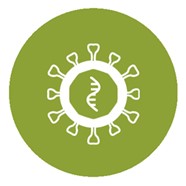There is an increasing number of alerts and reported outbreaks of foodborne viruses in foods. Viruses mostly associated with viral foodborne illnesses and outbreaks are Norovirus (NoV) and Hepatitis A virus (HAV).
Noroviruses have been recognized in Europe as a leading cause of foodborne gastroenteritis over the last decade. HAV causes very severe inflammation of the liver (hepatitis). However, HAV is prevailing in endemic countries outside Europa. It should be taken into consideration when importing food products originating from these countries. The WHO provides a map with an overview of the estimated Hepatitis A virus prevalence.
Major contamination routes are person-to-person or person-to-food (during picking, preparation of food) and contaminated water (e.g. applied as irrigation water, washing water, to dilute pesticides or cultivation water).
A broad range of foods have been implicated in NoV/HAV foodborne outbreaks:
- shellfish (e.g. oysters, mussels), crustaceans and their products;
- fruits - mainly berries - and vegetables (fresh and frozen);
- unpasteurized fruit and vegetable juices;
- ready-to-eat food such as sandwiches.
 Legislation
Legislation
There is actually no European legislation in place for Norovirus and Hepatitis A virus in fresh produce. However there are scientific opinions made by EFSA.
 Analysis methods
Analysis methods
NoV/HAV detection is still difficult and hampered by several limitations. Unlike most foodborne bacteria, viruses cannot grow in the environment since they need specific host cells to replicate. In general, the strategy for detection of foodborne viruses in food samples consists of 3 steps.
 Sample matrix
Sample matrix
For the samples, we talk mainly about fresh produce and fruits and about processed fruits and vegetables.
 Certified by
Certified by
Primoris is officially accredited for norovirus and hepatite A viruses. The accreditation certificate can be consulted on this website.

Newsletter highlight
Primoris is part of relana, the quality circle of a dozen European labs concerning analysis of pesticides and contaminants. Earlier this year Primoris saw a relana audit and received excellent feedback. In the first place the lab shows a high and stable level of quality and furthermore, the auditors were impressed with the competence of our staff.
Flash news
Due to the efforts of our in-house R&D team, we can now offer a drastically lower reporting time for the analysis of acrylamide, as well as a lowered reporting limit.
Legislation | Inorganic arsenic in cereal, rice and babyfood
On 06/03/2023 the European Commission published regulation 2023/0465 regarding the maximum levels of inorganic arsenic in certain foods.
As of now we will analyse maleic hydrazide (MH) using LC-MS/MS instead of UV, resulting in faster and more precise results.

